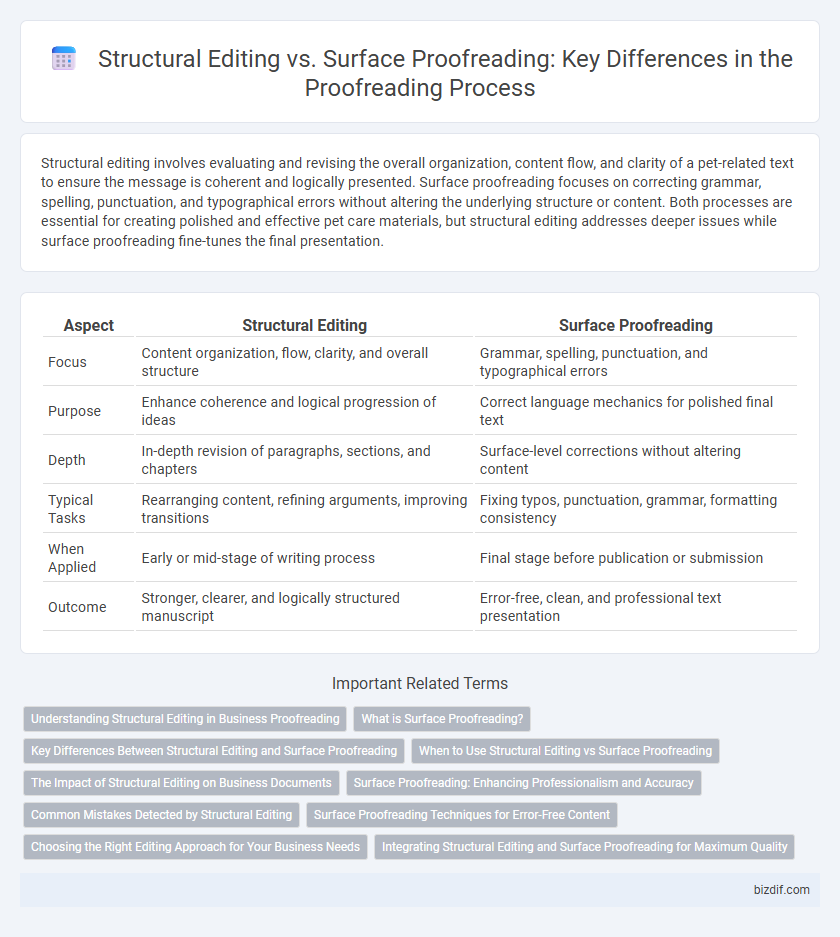Structural editing involves evaluating and revising the overall organization, content flow, and clarity of a pet-related text to ensure the message is coherent and logically presented. Surface proofreading focuses on correcting grammar, spelling, punctuation, and typographical errors without altering the underlying structure or content. Both processes are essential for creating polished and effective pet care materials, but structural editing addresses deeper issues while surface proofreading fine-tunes the final presentation.
Table of Comparison
| Aspect | Structural Editing | Surface Proofreading |
|---|---|---|
| Focus | Content organization, flow, clarity, and overall structure | Grammar, spelling, punctuation, and typographical errors |
| Purpose | Enhance coherence and logical progression of ideas | Correct language mechanics for polished final text |
| Depth | In-depth revision of paragraphs, sections, and chapters | Surface-level corrections without altering content |
| Typical Tasks | Rearranging content, refining arguments, improving transitions | Fixing typos, punctuation, grammar, formatting consistency |
| When Applied | Early or mid-stage of writing process | Final stage before publication or submission |
| Outcome | Stronger, clearer, and logically structured manuscript | Error-free, clean, and professional text presentation |
Understanding Structural Editing in Business Proofreading
Structural editing in business proofreading involves a comprehensive review of a document's organization, clarity, and logical flow to enhance overall communication effectiveness. This process addresses content coherence, paragraph structure, and alignment with the intended audience, ensuring that key messages are clearly conveyed. In contrast, surface proofreading focuses solely on correcting grammar, spelling, punctuation, and typographical errors without altering the document's foundational content or structure.
What is Surface Proofreading?
Surface proofreading involves meticulously reviewing the final draft to identify and correct superficial errors such as spelling, grammar, punctuation, and formatting inconsistencies. Unlike structural editing, which focuses on the organization and overall coherence of the text, surface proofreading ensures the text is error-free and polished for publication. This step is crucial for enhancing readability and maintaining professional quality in written content.
Key Differences Between Structural Editing and Surface Proofreading
Structural editing focuses on the overall organization, content flow, and coherence of a manuscript, addressing plot holes, pacing, and character development. Surface proofreading targets grammar, punctuation, spelling, and typographical errors, ensuring the text adheres to standard language conventions. Key differences lie in the scope: structural editing enhances the foundational elements of a text, while surface proofreading polishes its final presentation for readability and accuracy.
When to Use Structural Editing vs Surface Proofreading
Structural editing is essential during the early stages of manuscript development to address core issues such as plot coherence, character development, and overall organization, ensuring the content's foundation is solid. Surface proofreading is best applied in the final phase, focusing on correcting grammar, punctuation, spelling, and formatting errors to polish the text for publication. Authors should prioritize structural editing when major revisions are needed and reserve surface proofreading for refinement after the text's structure is finalized.
The Impact of Structural Editing on Business Documents
Structural editing transforms business documents by enhancing clarity, coherence, and logical flow, ensuring the content aligns with organizational goals and audience expectations. This process addresses paragraph organization, argument strength, and overall readability, which surface proofreading cannot achieve, as it focuses solely on grammar, punctuation, and spelling errors. Effective structural editing increases document professionalism, persuasive power, and decision-making impact, crucial for business success.
Surface Proofreading: Enhancing Professionalism and Accuracy
Surface proofreading enhances professionalism and accuracy by meticulously correcting grammar, punctuation, spelling, and typographical errors. It ensures clarity and readability, preventing misunderstandings and preserving the author's intended message. This detailed review refines the text's presentation, making it polished and suitable for professional or academic standards.
Common Mistakes Detected by Structural Editing
Structural editing detects common mistakes such as inconsistent plot development, weak character arcs, and unclear narrative flow, which impact the overall coherence and engagement of a manuscript. It uncovers gaps in logic, pacing issues, and structural imbalances that surface proofreading might overlook. Addressing these errors enhances the manuscript's foundation before detailed grammar and spelling corrections are applied.
Surface Proofreading Techniques for Error-Free Content
Surface proofreading techniques involve meticulously scanning text to identify and correct grammatical errors, spelling mistakes, and punctuation oversights. Employing tools such as spell checkers, grammar software, and style guides ensures consistency and accuracy across the content. Reading aloud and using backward reading methods further enhance the detection of subtle errors, resulting in polished, error-free text.
Choosing the Right Editing Approach for Your Business Needs
Selecting the appropriate editing approach depends on your business goals: structural editing focuses on improving the organization, clarity, and flow of content, which is essential for comprehensive revisions and enhancing overall message effectiveness. Surface proofreading targets correcting grammar, punctuation, spelling, and formatting errors, ensuring polished and error-free text ideal for final drafts. Evaluating the scope of your project and the desired outcome will help determine whether structural editing or surface proofreading best aligns with your business needs.
Integrating Structural Editing and Surface Proofreading for Maximum Quality
Integrating structural editing and surface proofreading enhances document quality by addressing both content coherence and language accuracy. Structural editing focuses on reorganizing ideas and improving narrative flow, while surface proofreading targets grammar, punctuation, and typographical errors to ensure clarity. By combining these processes, writers achieve a polished, well-organized text that communicates effectively and maintains professional standards.
Structural editing vs Surface proofreading Infographic

 bizdif.com
bizdif.com